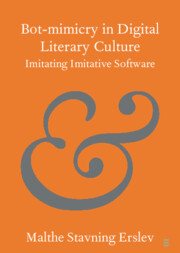Element contents
Bot-mimicry in Digital Literary Culture
Published online by Cambridge University Press: 03 May 2024
Summary
- Type
- Element
- Information
- Online ISBN: 9781009222426Publisher: Cambridge University PressPrint publication: 30 May 2024
References
- 3
- Cited by

